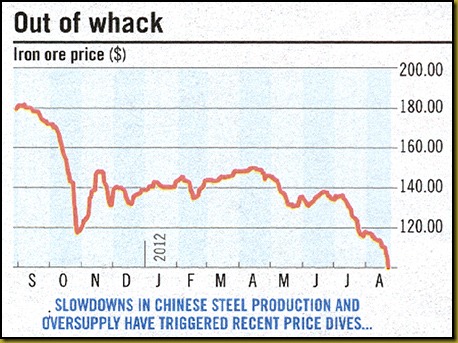Mining Boom Temporarily Over: Iron Ore Falls Under $100/Tonne
Back on the 21st of March I posted the item “Titbit: 30 Year ‘Mining’ Boom Might Only Last 5 Years”. Based on recent events it seems I might have been a bit optimistic with that thinking. From all reports the mining boom is temporarily well and truly over right now.
In the last few weeks the price of iron ore, one of our top exports, has fallen below US$100. Just 12 months ago the price of iron ore was up around US$185 per tonne and there were predictions from the experts that it could click over the magical US$200 per tonne before Christmas last year.

So iron ore has fallen a staggering 50 percent from its peak just 12 months ago.
Somewhat worse than that industry experts are predicting that it could go under US$90 per tonne in September and that it will probably level out at around US$85. They also advise that there is no reason to expect the price to improve in the near- to mid-term—probably not until the second half of 2013 and even then it will not get back to the glory-day heights of over $180 per tonne. The new-normal for iron ore by the end of 2013 is likely to be closer to US$135.
The second part of the problem is that most resource contracts are written up in US dollars. There are some exceptions but these are few. So with the Australian dollar currently being about US$1.05 this makes the effective value of the ore even less. To get the effective contract price you divide the US dollar price by the exchange rate; hence ore fetching US$92 in the market is actually only bringing in around AUD$87.60 to Australian mining companies.
What could happen to make the miners happier is that the Australian dollar could fall down to something like 85 cents. Then that would make a US$90 tonne of iron ore worth around AUD$106. This is exactly what the Reserve Bank has tried to do with the last four rate drops. Economic theory says that if the cash rate is reduced the value of the county’s currency goes down.
But this strategy didn’t work. The four rate drops by the Reserve Bank have had zero effect on the Australian dollar—so much for economic theory. And now the Reserve Bank is very concerned about dropping the cash rate any further in case it heats up the housing market, which is something they are desperate to avoid because real estate in Australia is already significantly over-valued.

Sadly the story for nickel (see Kitco 6 month chart above left), coal, and aluminium (see the LME Aluminium 6 month chart below right) is much the same. Only gas, uranium, and copper are more or less holding up.

And as for copper and uranium, well Western Australia doesn’t have many (any) copper or uranium mines.

